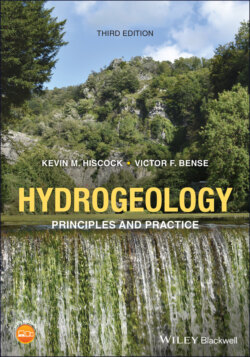Читать книгу Hydrogeology - Kevin M. Hiscock - Страница 40
1.7.3 Groundwater abstraction in North America
ОглавлениеA similar picture emerges of the importance of groundwater for the population of North America. In Canada, almost nine million people, or 30% of the population, rely on groundwater for domestic use (Government of Canada 2021). Approximately two‐thirds of these users live in rural areas where groundwater is a reliable and cheap water supply that can be conveniently abstracted close to the point of use. The remaining groundwater users are located primarily in smaller municipalities where groundwater provides the primary source for their water supply systems. For example, 100% of the population of Prince Edward Island and over 60% of the population of New Brunswick rely on groundwater for domestic supplies. In Ontario, a province where groundwater is also used predominantly for supplying municipalities, 29% of the population is reliant on groundwater. Furthermore, the predominant use of groundwater varies by province. In Ontario, Prince Edward Island, New Brunswick and the Yukon, the largest users of groundwater are municipalities; in Alberta, Saskatchewan and Manitoba, the main users are in the agricultural sector for livestock watering; in British Columbia, Quebec and the Northwest Territories, the principal users are in the industrial sector; and in Newfoundland and Nova Scotia, the predominant use is for rural domestic supplies. Prince Edward Island is almost totally dependent on groundwater for all its uses.
Fig. 1.12 Trends in water abstractions (fresh and saline) by water use category and total (fresh and saline) abstractions in the United States from 1960 to 2000 (Solley et al. 1998 and Hutson et al. 2004).
(Sources: Adapted from Solley, W.B., Pierce, R.R. and Perlman, H.A. (1998) Estimated use of water in the United States in 1995. United States Geological Survey Circular 1200, 71 pp; Hutson, S.S., Barber, N.L., Kenny, J.F. et al. (2004) Estimated use of water in the United States in 2000. United States Geological Survey Circular 1268, 46 pp.)
The abstraction of fresh and saline water in the United States from 1960 to 2000 as reported by Solley et al. (1998) and Hutson et al. (2004) is shown in Fig. 1.12. The estimated total abstraction for 1995 is 1522 × 106 m3 day−1 for all offstream uses (all uses except water used instream for hydroelectric power generation) and is 10% less than the 1980 peak estimate. This total has varied by less than 3% since 1985. In 2000, the estimated total water use in the United States is 1544 × 106 m3 day−1. Estimates of abstraction by source indicate that during 1995, total fresh surface water abstractions were 996 × 106 m3 day−1 and total groundwater abstractions were 293 × 106 m3 day−1 (or 23% of the combined freshwater abstractions). The respective figures for 2000 are 991 × 106 m3 day−1 and 316 × 106 m3 day−1, with 24% of freshwater abstractions from groundwater.
Total water abstraction for public water supply in the United States in 2000 is estimated to have been 163 × 106 m3 day−1, an 8% increase since 1995. This increase compares with a 7% growth in the population for the same period. Per capita public water supply use increased from about 678 L day−1 in 1995 to 683 L day−1 in 2000, but is still less than the per capita consumption of 696 L day−1 recorded for 1990.
The two largest water use categories in 2000 were cooling water for thermoelectric power generation (738 × 106 m3 day−1 of fresh and saline water) and irrigation (518 × 106 m3 day−1 of freshwater). Of these two categories, irrigation accounts for the greater abstraction of freshwater. The area of irrigated land increased nearly 7% between 1995 and 2000 with an increase in freshwater abstraction of 2% for this water use category. The area irrigated with sprinkler and micro‐irrigation systems has continued to rise and now comprises more than half of the total. In 2000, surface water was the primary source of irrigation water in the arid West and the Mountain States and groundwater was the primary source in the Central States. California, Idaho, Colorado and Nebraska combined accounted for one‐half of the total irrigation water abstractions. California and Idaho accounted for 40% of surface water abstractions and California and Nebraska accounted for one‐third of groundwater abstractions. In general, groundwater abstractions for irrigation have increased significantly. In 1950, groundwater accounted for 23% of total irrigation water, while in 2000 it accounted for 42%.
